Algal Diversity of the Pamir High Mountain Mineral Springs in Environmental Variables Gradient - Juniper Publishers
Juniper Publishers- Open Access Journal of Environmental Sciences & Natural Resources
Algal Diversity of the Pamir High Mountain Mineral Springs in Environmental Variables Gradient
Authored by Barinova SS
Abstract
Paper represents the results of our study in Pamir mineral and hot springs. Altogether 134 diatom species (166 with infraspecific taxa) were revealed from 150 periphytonic samples. The correlation of species richness with habitat altitude in the Pamir high mountains was identified with help of the Distance Weighted Least Square method in Statistica 12.0 program. It has been conclude that both global related parameters altitude and temperature can define the algal communities' development in high mountain habitats of Pamir. The special factor, water pH was revealed as regulating parameter for diatom species richness in studied hot and mineral water springs. The infraspecific variability index that we calculated for Pamir mineral springs communities of diatom algae was 1.24, and was highest in comparison of regional high mountain algal floras. Index is increased with habitat altitude and show high adaptation potential of Pamir diatoms.
Keywords: Algae; Pamir; Mineral water sources; Altitude
Introduction
The algal biodiversity and environmental conditions relationships are determined by adaptation level of the species and the community. When operating with alpha-diversity of freshwater algae we use a multilevel approach with the hierarchy of levels such as infraspecies variation level, species composition, community composition, and flora of a water body [1]. Up to now it is still a problem to define the role of particular environmental variables as well as to predict the community's response to environmental change [2]. One of the major climatically related parameter is the altitude of algal community habitat. We give attention earlier to the freshwater community response on the high mountain areas climatic gradients [3-10]. But up to now we studied habitats on the altitude up to 2,500m. In this is very important to study climatic factors influence on the algal communities of long-term stabile environments such as high mountain mineral water sources. One of the highest mountain areas of Eurasia is Pamir that closely related to Hindu Cush and Himalayas. A study of the species composition of algae, including the diatoms (Bacillariophyta), inhabiting thermal and mineral springs is of great scientific interest that was our aim of work.
Description of study site and referenced data
Pamir is very rich in thermal and mineral waters, which in a way are unique habitats characterized by a constantly and high temperature from 10 °C to 86 °C and various chemical compositions saturated with carbon dioxide and nitrogen gases such as hydrogen sulfide-siliceous, hydrocarbonate- sulphate-calcium-magnesium, chloride-sulfate-calcium-sodium, hydrocarbonate-sulfate-sodium and weak radon-chloride- sulfate [11-12]. In these waters, for many centuries, a special community of algae with a specific species composition and degree of species resistance to peculiarly extreme environmental conditions was formed and developed. The referenced literature data on Pamir regional flora is known from sporadically collected material in period 1930-1983 [13-17]. The regular work was started by G.R. Jumaeva in 2000 and continued up to 2006 [18]. Altogether 114 diatom species (157 with infraspecific taxa) were revealed for thermal and mineral springs of Pamir before our study.
Material and Methods
The material for this analysis is represented by our own data from 150 samples collected during few field trips in summer period of 2000-2015 from various sources Jelandy, Avdzh, Garm-Chashma, Sassykbulak, Sist and Barshor located at an altitude from 2,360m to 3,800m, above the sea level (Figure 1). Algal periphytonic samples were collected and processed from various places, springs, and griffins with a water temperature of 10 °C to 86 °C (Table 1). The statistical methods were chosen in accordance to analytical purposes using the program Statistica 12.0.


Results and Discussion
As can be seen in (Table 1), the maximal water temperature of springs is fluctuated in large range. Active water proton concentration have also range from acidic pH in the Sist spring to low alkaline in the Jelandy hot springs. Altogether 134 diatom species (166 with infraspecific taxa) were revealed from 150 periphytonic samples. Low-alkaline hot springs of Jelandy and Avdzh have richest diatom community with 76 and 41 species respectively. In contrary, acidic water communities of Sist and Barshor were represented by 9 and 13 species respectively. This data let us to assume that water pH can regulate species richness of studied water springs in Pamir. Especial interest is represented the species richness distribution over the altitude gradient (Figure 2) show that specific and infraspecific data are fluctuated synchronously over the altitude of spring habitats. Species richness is increased with altitude excluding the Sassykbulak spring community only which is placed on the altitude of 3,800m a.s.l. May be this spring has some special factors that inhibit the development of diatoms at this altitude such as water debit or temperature.
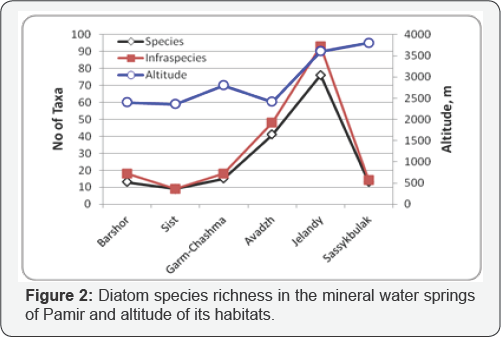
We calculated earlier the index of infraspecific variation (Ssp/Sp Index) that was correlated not only with algal community habitat altitude but also with the geographical position of water body in respect of it latitude in the Northern Hemisphere [3,5-10]. The algal floras of close related high mountain areas all consists the diatom algae as about half of the species list [19]. Therefore, our calculation of Ssp/Sp Index results can be comparable with other regional floras and reflect the adaptation style of the algal flora as a whole. Ssp/Sp index is increase with altitude of habitats of mentioned regional floras such as in Hindu Cush, Caucasus, South-Tajik depression or Iran that was calculated by us on the base of [20] as 1.19. Figure 3 shows infraspecific variation Index in the mineral water springs of Pamir which is about 1.24 and fluctuated in opposite direction with habitats altitude as can be recognize in the trend lines. This is highest index value for the studied region in the area with highest altitude.
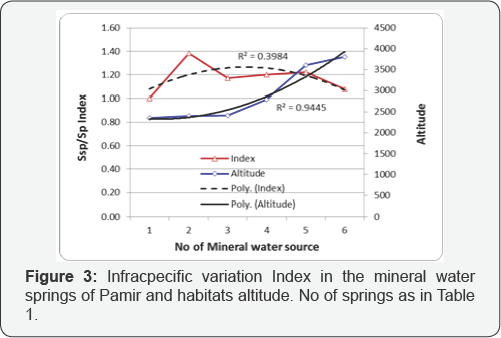
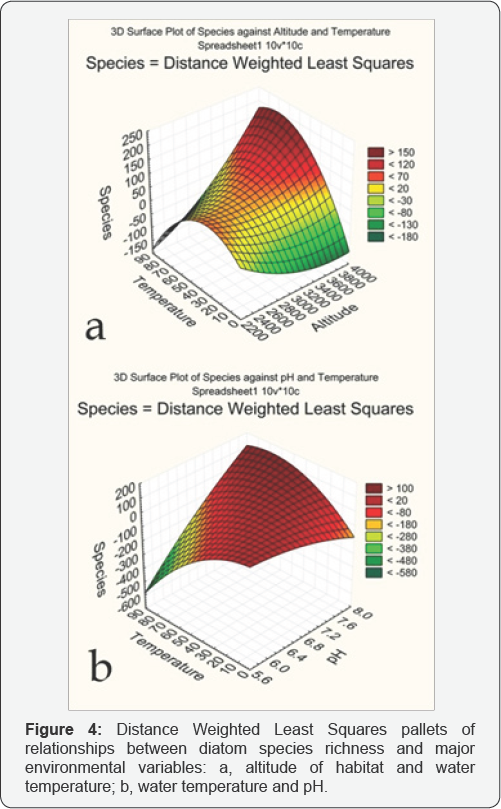
The basic macro-climatic variables that support of photosynthetic activity are the sunlight and temperature. However, the same factors are the global and defined the life and evolution [21]. It is difficult to compare the global temperature fluctuation and algal communities development because the data are or not enough, or have incomparable scale. But in our material we compare the distribution of diatom species richness over major environmental variables that partly are climatically- related and partly are represent especial characteristics of mineral springs (Figure 4). Statistically generated surfaces of distribution on the base of Table 1 data show that water temperature in mineral springs of Pamir is stimulating factor for diatom species richness (Figure 4a) which increased with altitude. In the same time, low-alkaline water pH also stimulates algal diversity but in lowermost temperature waters only (Figure 4b).
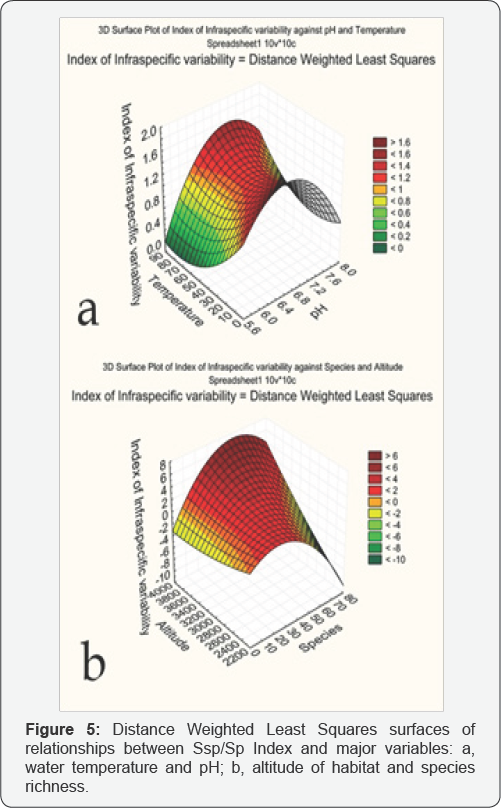
Calculation of the Distance Weighted Squares surfaces for Ssp/Sp Index is revealing a complex dependence of it on water temperature and pH. Figure 5a demonstrates that infraspecific variability is highest in the circumneutral waters, whereas the water temperature was not so influenced by it. Figure 5b represented the tendency of infraspecific variability increasing for the high altitude communities where species richness was not so large. This calculation let us to assume that altitude of habitat play the major role in infraspecific variability of diatom algae in Pamir mineral and hot springs as a mechanism for species protection from the environmental stress for future surviving and development.
Conclusion
The gradient of solar radiation and temperature is define not only species richness of algal communities as a whole but also species content [22] that was revealed in the high latitude habitats [2,21,23]. Because these pair of climatically related parameters is fluctuated synchronously and we revealed correlation of species richness with habitat altitude in the Pamir high mountains that mean that both global related parameters can define the algal communities' development in the studied high mountain habitats in Pamir. Our study represents altogether 134 diatom species (166 with infraspecific taxa). The special factor, water pH was found as regulating parameters for diatom species richness of studied hot and mineral water springs in Pamir. The infraspecific variability index calculated for Pamir mineral springs communities of diatom algae was 1.24. This is highest value in comparison of close high mountain regional floras. Index is increased with habitat altitude and show high adaptation potential of Pamir diatoms.
For more articles in Open Access Journal of Environmental Sciences & Natural Resources please click on: https://juniperpublishers.com/ijesnr/index.php



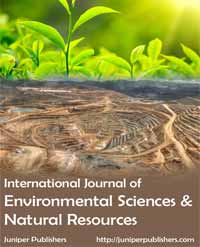
Comments
Post a Comment